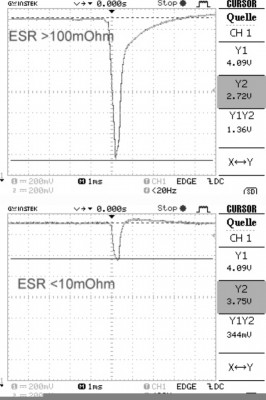Be aware that a GSM module will charge up to 2 Ampere peak current during 2 Watt TX power
Take care that your power supply will be able to drive the current peaks. Have a look on short PCB tracks in right width. And have a very close look on a capacitor with low impedance connceted to the GSM module. Remember that the fallback for a 3G or 4G module is still GSM/GPRS. 3G/4G modules will charge the high currents peaks as well. Do not forget that at GPRS class 12 you will have four peaks in one time slot. The duty cycle will rise to 50%. And if you ignore this hint or if your contracted manufacturer is so stupid and will replace the capacitor with an ESR of 10 mOhm to one with 100 mOhm, then your module will get a minus delta peak on supply voltage . In the graphic you can see a drop down to 2,72 Volt. The voltage was measured direct at the supply voltage pin of the GSM module. The minimum voltage of the most GSM modules is 3,2 to 3,4 Volt. Even if you do not reach the minimum voltage, the legal RF parameter could jump out of the specification. A module approved on R&TTE or FCI could generate undesirable emission or loss its sensitivity. Nobody can know, what will happen with the RF parameters of your cellular module, if you run it with a not allowed supply voltage.
If you still have questions about power supply, battery, low ESR capacitors or antennas for your IoT or M2M applications, then have a look in IoT M2M Cookbook listed here:
http://www.gsm-modem.de/M2M/m2m_iot_cookbook/
